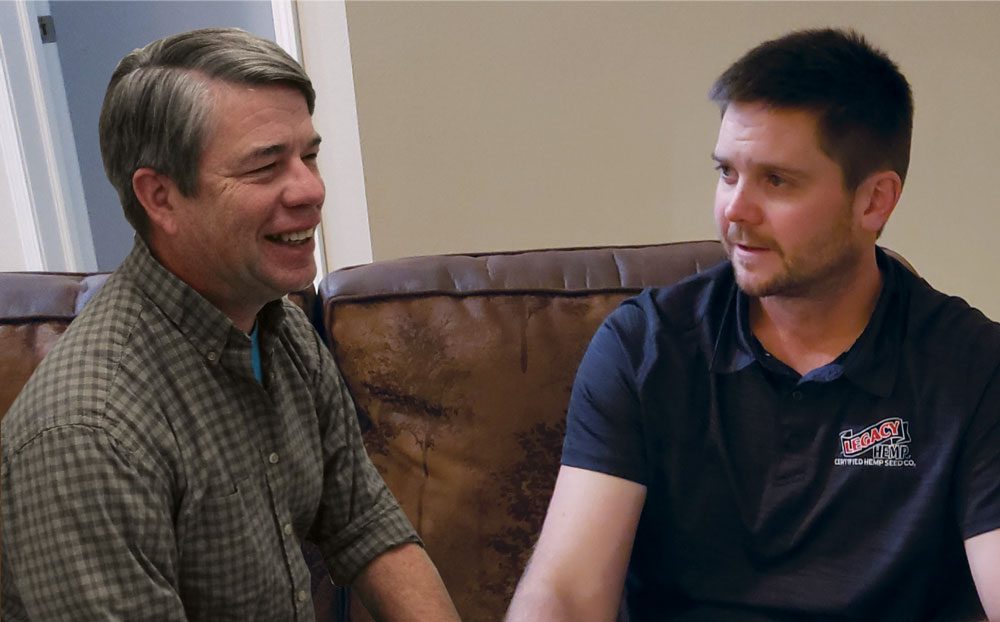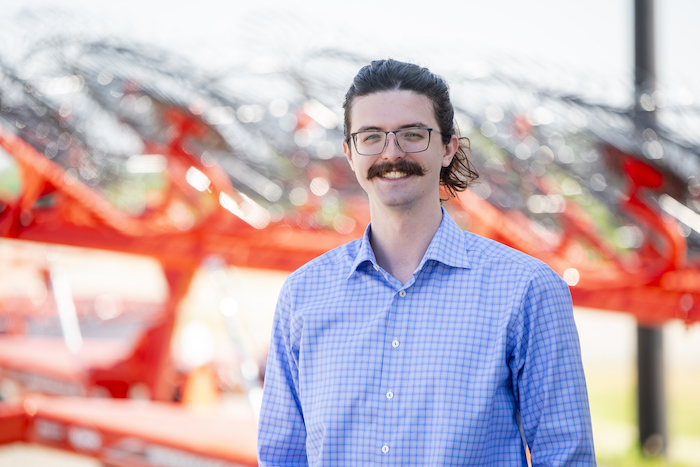Pictured Above: Bryan Parr (r) and Bob Pearce (l) have both worked for several years with hemp farmers to provide information and resources on how to grow this new commodity. Their experiences gave them a lot to talk about, including a mutual agreement that the CBD price bubble can’t last forever.
Bob Pearce, Interim Director of Hemp Programs, University of Kentucky
Bryan Parr, Agronomist, Legacy Hemp
Bryan Parr: Especially on the CBD side of things, there are so many farmers just jumping into this industry, because they hear people are making money or this is a way to save their farm or what-have-you. But most people I’ve talked to have given very little thought to who or where they’re going to sell their hemp crop. They simply thought that by growing it, somebody would buy it. And that is one of the biggest mistakes.
Bob Pearce: Yes, that’s one of the first pieces of advice I give to growers: talk to the processors. If we look 5 years down the road, only a small percentage of those companies are going to still be around. I encourage our growers not only to have some sort of a contract or an agreement with a processor for where this material’s going to be sold, but also do some homework on that processor. Do they have financial stability? Do they have the knowledge and the resources that growers need? Do they have a business plan? I’m afraid some of these processors jumped in and they think somewhere out there, if you put CBD in a bottle, people will buy it.
The other big piece of advice I always finish my presentations to growers with is: this is a risky business. There is no crop insurance, there is no safety net. We could have a hemp crop in the ground, FDA could make a decision, especially when it comes to the CBD, and that could have adverse effects on the value of that crop.
Parr: I caution growers on that as well. There are a lot of processors out there making big promises to growers and they’re doing this on speculation that they will receive the funding to supply these growers with income at the end of the season.
“We’re caught in a loop where manufacturers are interested in using hemp fiber if we can prove to them that there’s going be a consistent supply. But before a lot of growers are going to grow it, they want to know that they’ve got some place to sell it. Everybody’s waiting on somebody else to make the next move…”
Some of these processors don’t disclose the fact they may not actually have the financial means at the time we’re speaking to actually do the things they’re talking about. Hemp’s just not the straight forward agriculture like we’re so used to on just about every other crop.
Pearce: Right now we’re in a little bit of a CBD bubble. Values seem to be really inflated at the moment.
As we see more growers getting into hemp, I don’t know at what point we’re going to hit market saturation. Even if the market grows, the U.S. grower is good at producing. They will keep up with or surpass that market.
There’s going to be a role for hemp grain and fiber uses, as well. I’m pretty excited about the opportunity there might be to extend the fiber uses beyond things we’re thinking about right now, perhaps bioplastics or other types of materials.
Parr: I see the CBD industry the same way. We’ve had quite the explosion here in Wisconsin over the last 2 years. Last year, we saw 250 growers, primarily for CBD production. The second year, we were just shy of 1,500 growers.
We’re getting to the point where commoditization will happen. We really need to hone in on what type of demand is actually out there. I’m not sure anybody really knows where the demand is. It’s very easy to oversupply that market.
Hemp grain and fiber have been sitting in the corner of the room, so to speak. Grain and fiber has a lot of upside potential, where we are not currently oversupplying that market. I think there’s a lot of interest in the fiber industry, but it just seems to be the slowest growing at this point in time.
Pearce: I think it sounds like we’re actually more in agreement than disagreement as far as where the market is heading. We might think about fiber right now as a slow and steady wins the race kind of thing. As a scientist, I’d rather see the market grow that way.
Another concern with the way the supply has grown ... I’m really not sure we have the processing capacity to process all of this field material in the next few months before it starts to deteriorate.
Parr: I completely agree. There are just simply not very many places in this country that are doing much with fiber. There’s a few mom and pop things popping up here and there. But, on a commercial scale, there’s really not much to speak of.
“We really need to hone in on what type of demand is actually out there. I’m not sure anybody really knows where the demand is. It’s very easy to oversupply that market…”
Pearce: That’s true. Right now we’re caught in a loop where manufacturers are interested in using the fiber if we can prove to them that there’s going be a consistent supply of it, because they’re going to have to retool their manufacturing processes a little bit to handle a different fiber. They want to know that there’s going to be a consistent supply. We’re in this loop where everybody’s waiting on somebody else to make the next move.
Parr: One aspect that we’ve tried to enter into on the fiber world is utilizing the stalks after grain production. They may not be of the highest quality fibers, but it is a supply that growers would have without dedicating their entire crop solely to fiber production.
Pearce: Yeah, I think based on what we’ve seen here, the dual use model has some economic value to the grower. Either one of those commodities, by themselves, is maybe marginal in terms of return. But you put the two of them together, if you’ve got markets for both, that makes an attractive package to improve grower profitability.
Conversations in Ag: Introduction
Commercial Vehicle Business vs. Ag Equipment
Shortliners Ask: Is Ag’s Future Autonomous?
Women Add a Different Perspective to the Sales Process
2 Industries, 1 Problem: Recruiting Technician
33 Years Later: Lessons Learned Make Today’s Dealers Stronger
Hemp’s Future: What Will Happen When the Dust Settles?
Early Experience & Advantage in European Brands
Two Sides Examine 2-Step Distribution
Overcoming Adversity Through Technology & Diversity
Getting Real: Farmers Growing Too Much Corn...
Research: Can It Be a Dealership’s Business?
Dealer Structures: Europe, North America a World Apart
Trading Places: Farmer vs. Dealer Expectations
Dealer & Economist Compare Notes on Challenges Global Economy has on U.S. Agriculture
Avoiding Hefty Fines When Doing Business Out of State
Thinking Ahead: How Should Dealers Prepare A Succession Plan?







